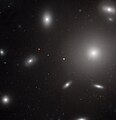Сурет:NGC 4874 HST.jpg
Навигацияға өту
Іздеуге өту

Бұл алдын ала көрудің өлшемі: 578 × 600 пиксел. Басқа ажыратылымдықтар: 231 × 240 пиксел | 463 × 480 пиксел | 740 × 768 пиксел | 987 × 1024 пиксел | 1973 × 2048 пиксел | 3864 × 4010 пиксел.
Түпнұсқа файл (3864 × 4010 пиксел, файл өлшемі: 5,95 MB, MIME түрі: image/jpeg)
Файл тарихы
Файл сол кезде қалай көрінгенін көру үшін күн/уақыт дегенге басыңыз.
| Күн/Уақыт | Нобай | Өлшемдер | Қатысушы | Пікір | |
|---|---|---|---|---|---|
| қазіргі | 16:55, 2011 ж. қыркүйектің 20 |  | 3864 × 4010 (5,95 MB) | Jmencisom |
Файл қолданылуы
Бұл файлды мына бет қолданады:
Глобалды файл қолданылуы
Бұл файл келесі басқа уикилерде қолданылады:
- ar.wikipedia.org жобасында қолданылуы
- arz.wikipedia.org жобасында қолданылуы
- ast.wikipedia.org жобасында қолданылуы
- az.wikipedia.org жобасында қолданылуы
- be.wikipedia.org жобасында қолданылуы
- ce.wikipedia.org жобасында қолданылуы
- cs.wikipedia.org жобасында қолданылуы
- de.wikipedia.org жобасында қолданылуы
- diq.wikipedia.org жобасында қолданылуы
- en.wikipedia.org жобасында қолданылуы
- et.wikipedia.org жобасында қолданылуы
- eu.wikipedia.org жобасында қолданылуы
- fr.wikipedia.org жобасында қолданылуы
- hr.wikipedia.org жобасында қолданылуы
- it.wikipedia.org жобасында қолданылуы
- ja.wikipedia.org жобасында қолданылуы
- ko.wikipedia.org жобасында қолданылуы
- mk.wikipedia.org жобасында қолданылуы
- nl.wikipedia.org жобасында қолданылуы
- pl.wikipedia.org жобасында қолданылуы
- ru.wikipedia.org жобасында қолданылуы
- sk.wikipedia.org жобасында қолданылуы
- sl.wikipedia.org жобасында қолданылуы
- tt.wikipedia.org жобасында қолданылуы
- uk.wikipedia.org жобасында қолданылуы
- uz.wikipedia.org жобасында қолданылуы
- www.wikidata.org жобасында қолданылуы
- zh.wikipedia.org жобасында қолданылуы